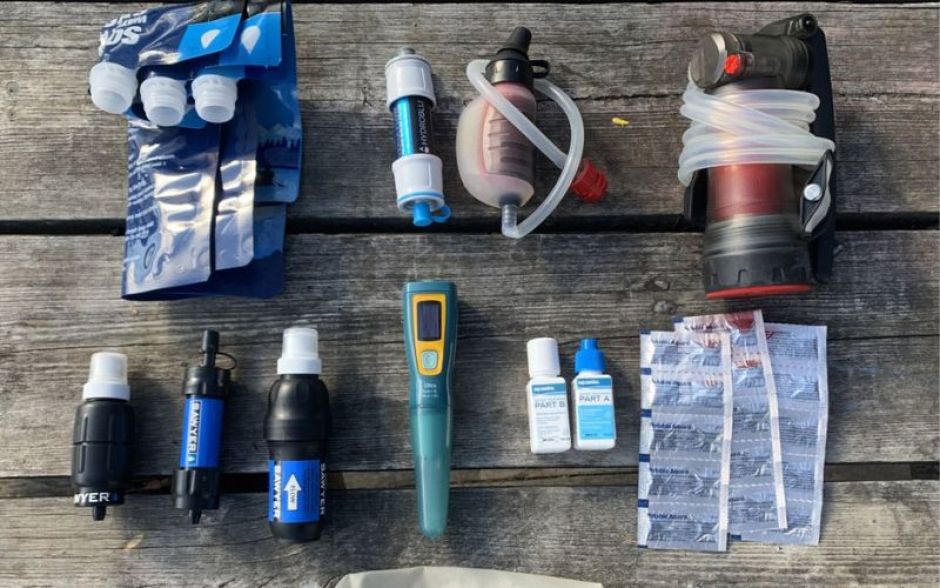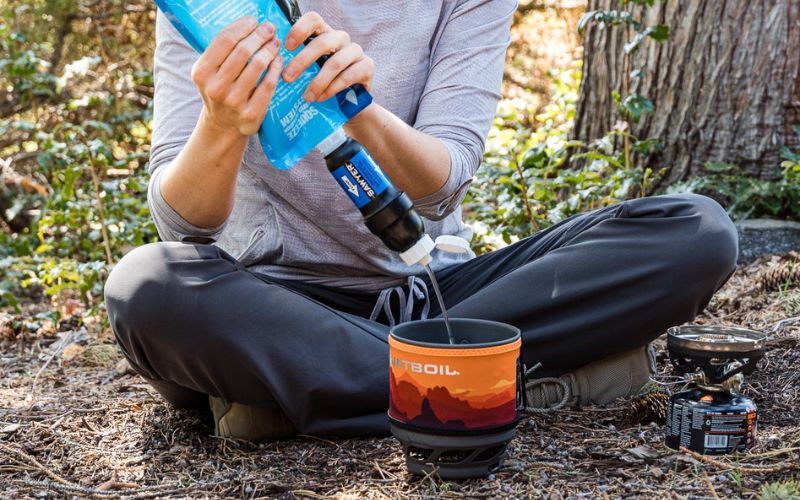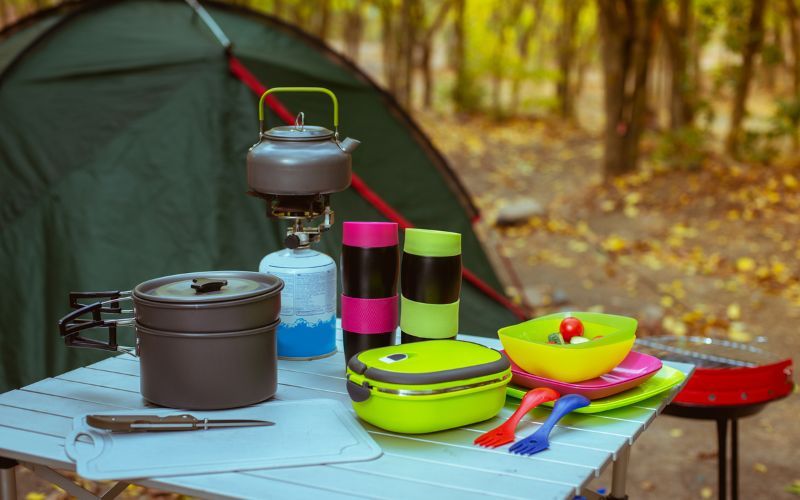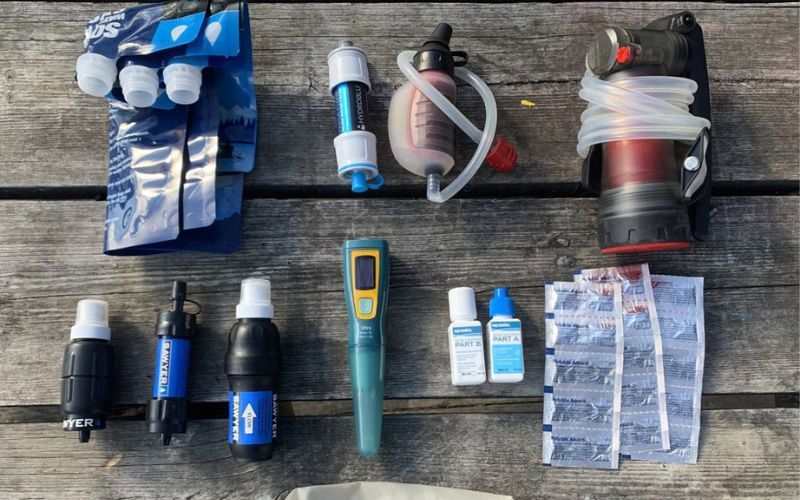
Water Purification: The Vital Aspect of Nutrition & Hydration Super Guide 2023
In the sphere of outdoor adventures, Water Purification stands as a sentinel of health and survival. Every trekker, mountaineer, or outdoor enthusiast knows the importance of hydration. Yet, it’s not merely about quantity but the quality of water that one ingests. The wild is replete with pristine-looking streams and lakes, but appearances can deceive. A clear stream might harbor pathogens, and it’s here that the science and art of Water Purification come into play. Delving deep into its significance, methods, and evolving trends, we underline the imperative of purified water in ensuring nutritional well-being.

Table of Contents – Water Purification
The Unseen Perils: Why Water Purification is Crucial
Water, the sustenance of life and the elemental elixir that courses through our planet, often bears more than meets the eye. When we gaze upon the serene facade of a lake or the gentle flow of a stream, it’s tempting to believe in its purity. However, beneath this transparent veneer lies a potential minefield of dangers, both biological and chemical, many of which remain invisible to the naked eye.
Biologically, untreated water sources can teem with a plethora of pathogens, ranging from bacteria such as E. coli and Salmonella to protozoa like Giardia. Viruses, less commonly but still potentially present, can include threats like Hepatitis A. These microorganisms, even if present in minuscule quantities, have the potential to wreak havoc on the human body, causing ailments that vary from mild gastrointestinal discomforts to severe, life-threatening conditions.

Chemical contaminants further complicate the picture. Pesticide runoff, industrial waste, or even naturally occurring substances like heavy metals can contaminate water sources. Consuming water laced with these chemicals can lead to a range of health issues, from short-term illnesses to chronic conditions and developmental problems.
Moreover, water’s physical appearance is a deceptive metric for its safety. Clear water isn’t necessarily clean water. Many of the most dangerous pathogens and toxins are completely invisible, making sensory evaluation an unreliable method for judging purity.
In treacherous outdoor environments, the importance of water purification is amplified manifold. Dehydration is a potent enemy, but drinking contaminated water poses an equally significant threat. The balance between hydration and safety becomes a tightrope, with Water Purification acting as the safety net, ensuring adventurers can quench their thirst without the lurking dread of potential illness.
Thus, delving into the world of Water Purification is more than an exercise in preparedness; it’s an essential strategy in the holistic approach to health and well-being, especially in unpredictable outdoor terrains. Knowledge and application of effective purification methods can mean the difference between a successful expedition and a health nightmare.
Traditional Methods: Boiling and Distillation – Water Purification
When delving into the annals of water purification, two methods have withstood the test of time, holding their own against a backdrop of rapid technological advancements: boiling and distillation. Rooted in antiquity, these processes represent humanity’s age-old fight against waterborne pathogens and the quest for potable water.
Boiling, at its core, is a simple, accessible, and effective method. By raising the water’s temperature to its boiling point and maintaining that state for a set duration, it is possible to neutralize most pathogens present in the water. Viruses, bacteria, and protozoa are generally not adapted to survive at such high temperatures, making boiling an almost universally effective means of biological decontamination.

However, boiling has its nuances. The necessary duration for effective purification varies based on altitude. At sea level, a full rolling boil maintained for just one minute is generally sufficient. Yet, as altitude increases and the boiling point of water decreases, the time required extends. For instance, at altitudes above 2,000 meters, it’s recommended to boil water for at least three minutes to ensure adequate purification.
While boiling excels in neutralizing biological contaminants, it does little to address chemical pollutants. Enter distillation, a process rooted in the principle of utilizing differences in substance volatility.
Distillation involves boiling water and then capturing and condensing the resultant steam back into a liquid. This method leverages the fact that many contaminants have different boiling points than water. As water is vaporized, most heavy contaminants – be they salts, metals, or certain chemical compounds – are left behind. The condensed steam, now transformed back into water, is significantly purer than its source.
Yet, while distillation can effectively remove a wide range of contaminants, it’s not an all-encompassing solution. Some volatile organic compounds (VOCs) possess boiling points close to or lower than that of water. Therefore, they may still be carried over with the steam, necessitating additional purification stages or methods to ensure complete removal.
Both boiling and distillation are energy-intensive processes. In situations where fuel or power is limited, the feasibility of these methods might be constrained. However, their longevity in the realm of water purification is a testament to their fundamental efficacy. As traditional as they might be, these methods have provided the blueprint for many modern purification systems and continue to serve as vital tools in the quest for safe, potable water.
Modern Marvels: Filtration Systems – Water Purification
As civilization advances and our understanding of contaminants and their deleterious effects deepens, the technological response has been nothing short of revolutionary. Modern filtration systems, products of intricate research and innovative engineering, now offer an unmatched assurance of purity, catering to diverse needs and challenges. These systems are not just about purifying water—they represent a commitment to health, longevity, and the environment.

Activated Carbon Filters: Born from the principle of adsorption, activated carbon filters utilize a vast surface area laden with crannies and nooks to trap contaminants. The carbon, often sourced from coconut shells or wood, is ‘activated’ by treating it to open up millions of tiny pores between the carbon atoms. This results in filters capable of reducing pollutants like chlorine, sediment, volatile organic compounds, and even certain parasites. Moreover, the carbon imparts a palatability to the water purification, improving taste and odor.
Reverse Osmosis Systems: Considered the gold standard in water purification, reverse osmosis (RO) leverages a semipermeable membrane to strip water of an extensive array of contaminants. From heavy metals like lead and arsenic to microscopic pathogens, the precision of RO is unparalleled. Modern units often come integrated with pre and post-filters, ensuring comprehensive purification and mineral balance restoration, thus providing not just pure, but also mineral-rich water.
Ultraviolet (UV) Purifiers: Harnessing the lethal prowess of ultraviolet light, UV purifiers offer a chemical-free route to disinfection. When water is exposed to UV-C light at specific intensities, it results in the destruction of harmful bacteria, viruses, and cysts. This method is especially prized for its ability to kill waterborne pathogens without adding chemicals or altering the water’s taste or odor.
Nanofiltration and Ultrafiltration: Often considered cousins of RO, these systems utilize membranes with different pore sizes to tackle contaminants. While nanofiltration is adept at softening water and removing divalent ions, ultrafiltration excels in removing bacteria, viruses, and colloidal particles. These systems are becoming increasingly popular in regions with specific water challenges, providing solutions tailored to unique contaminant profiles.

Ion Exchange Systems: Primarily used to soften water, ion exchange systems operate on a simple yet effective principle. Resin beads within the system capture and remove unwanted ions (like calcium and magnesium) and replace them with other ions (usually sodium), thus mitigating issues related to hard water. Modern iterations are working on reducing sodium discharge, making the process more environmentally friendly.
In the vast landscape of water purification, these modern marvels stand as beacons of human ingenuity. They are a testament to our relentless pursuit of health and well-being. As contaminants evolve and new challenges emerge, the science of water filtration continues its relentless march forward, promising safer, purer, and more accessible water for all. The onus lies on consumers and stakeholders to stay informed, making choices that not only serve their immediate needs but also contribute to a sustainable, healthy future.
Chemical Purification: Tablets and Drops – Water Purification
In the diverse landscape of water purification, the utilization of chemicals—specifically in the form of tablets and drops—has carved a niche for itself, providing a unique balance of convenience, portability, and efficacy. Over the years, as the intricacies of waterborne pathogens and contaminants became better understood, the science behind chemical purification evolved, honing its ability to offer drinkable water in various contexts, from wilderness adventures to emergency situations.
At the heart of chemical purification lies the targeted neutralization of harmful organisms. Different chemicals disrupt the cellular processes of pathogens or inhibit their ability to reproduce. The beauty of this approach lies in its simplicity: with the right chemical agent, a potentially harmful source of water can be transformed into a safe one with just a few minutes of wait time.
Among the most commonly employed agents are iodine and chlorine. Iodine, whether in tablet or liquid form, is a potent biocide. When introduced to water, it works swiftly to neutralize bacteria, viruses, and many cysts. However, its efficacy can be influenced by factors like water temperature, pH, and organic content. Cold, acidic, or murky water might necessitate a longer treatment time or higher iodine concentration. A drawback to iodine is its distinct taste, which some find off-putting. Additionally, long-term consumption of iodine-treated water isn’t recommended for certain groups, such as pregnant women or those with thyroid conditions.
Chlorine, often in the form of sodium dichloroisocyanurate tablets or liquid bleach, offers another widely-accepted chemical treatment option. Chlorine’s modus operandi is similar to iodine, but with the added advantage of leaving water with a more palatable taste. However, like iodine, chlorine’s effectiveness can be compromised by colder or murkier water. It also struggles against certain protozoan cysts, such as Cryptosporidium.
Recently, chlorine dioxide tablets and drops have emerged as a potent alternative. Unlike its counterparts, chlorine dioxide excels in eliminating even the more resistant pathogens, including Cryptosporidium. It’s also less affected by the water’s turbidity or temperature. The trade-off? A slightly longer treatment time, usually around four hours for full spectrum protection.
But the use of chemicals doesn’t come without challenges. Over-reliance on chemical methods, especially in regions with heavily polluted water, can introduce harmful by-products due to chemical reactions with organic contaminants. Also, over time, certain pathogens might develop resistance to these chemicals, reducing the method’s effectiveness.
In conclusion, while chemical purification, particularly tablets and drops, offers a convenient and lightweight solution to water treatment, understanding their strengths, limitations, and best application scenarios is crucial. When used judiciously, they can be indispensable tools for the modern adventurer or emergency responder, but they should be considered as part of a broader strategy for ensuring access to safe drinking water.
Innovations in Water Purification
The relentless march of technological evolution has not spared the domain of water purification. Driven by a collective recognition of the paramount importance of clean water, both for health and survival, cutting-edge innovations have continuously emerged, enhancing our capability to obtain potable water from even the most compromised sources. This progression in technology reflects the human drive to enhance safety, increase efficiency, and accommodate diverse situations where access to clean water is crucial.
One of the most groundbreaking innovations is the ultraviolet (UV) light purification system. A far cry from traditional methods, UV light devices utilize short-wavelength ultraviolet light to kill or inactivate microorganisms, thus thwarting their ability to reproduce. This neutralizes threats from pathogens without adding any chemicals to the water, preventing potential taste or health issues. Devices such as the SteriPEN have become increasingly popular among hikers and international travelers due to their compact size and rapid purification process. However, for UV light to be effective, the water needs to be relatively clear, which might require pre-filtering in some scenarios.
The rise of nanotechnology in water purification signifies another giant leap. Nanofilters, comprising minuscule pores, can effectively trap contaminants, including heavy metals, organic compounds, and even bacteria and viruses. Their microscopic precision offers a high level of purification, often comparable to or even exceeding that of many commercial purification systems. Moreover, these filters can often be integrated into portable devices, ensuring clean water access in remote locations.
Another game-changer has been the portable osmosis systems. Leveraging the principle of reverse osmosis, these systems push water through a semi-permeable membrane, filtering out contaminants down to the molecular level. Historically, reverse osmosis was reserved for stationary, large-scale operations, but advancements have allowed its miniaturization into handheld, portable devices. This has opened up new possibilities for adventurers and emergency responders alike, providing them with the capability to purify even highly compromised water sources.
In the quest for sustainability, there’s also been a surge in eco-friendly purification methods. Bio-sand filters, for instance, use natural processes involving layers of sand and microorganisms to filter and purify water. While not necessarily a new technology, its adaptation and optimization for modern use mark an intersection of tradition and innovation, emphasizing environmentally conscious solutions.
Lastly, smart purification systems, integrating sensors and connectivity, are beginning to make waves. These systems can analyze water quality in real-time, adjusting purification methods accordingly and providing users with immediate feedback. Such intelligent systems not only assure users of the water’s safety but also adapt to varied conditions, ensuring optimal purification with minimal waste.
In essence, the modern era of water purification is marked by a synthesis of diverse technologies, both emergent and time-tested. As challenges related to water scarcity and contamination continue to escalate, these innovations don’t just represent scientific progress—they signify hope, safety, and resilience in a rapidly changing world.
Natural Methods: Harnessing Plants and Solar Power – Water Purification
The intersection of ancient wisdom and modern understanding has brought forth unique water purification strategies that are not only environmentally friendly but also exceptionally resourceful. Among these, the utilization of plants and the power of the sun stand out as potent, sustainable, and often overlooked methods. Their efficacy, rooted in nature’s intricate mechanisms, offers us reliable options that align with ecological preservation and minimal resource expenditure.
Utilizing Phytoremediation with Plants: Phytoremediation is the process by which certain plants, known for their ability to extract, stabilize, or degrade contaminants, are used to purify water. These plants, often referred to as hyperaccumulators, can absorb and concentrate heavy metals from their environment. For instance, water hyacinths and duckweed are known to reduce levels of pathogens and other contaminants when they are allowed to thrive in polluted water bodies.
The roots of these plants, teeming with beneficial microbes, break down organic pollutants and trap harmful metals. This not only purifies the water but also rejuvenates the aquatic ecosystem, fostering the growth of beneficial organisms. However, while promising, this method does require careful management to prevent the overgrowth of these plants, which can otherwise become invasive.
Solar Disinfection (SODIS): A blend of simplicity and efficacy, SODIS is a technique wherein water is poured into transparent plastic bottles and then exposed to sunlight for several hours. The UV-A rays from the sun interact with the oxygen dissolved in the water to produce reactive forms of oxygen, effectively eliminating a range of pathogens. For regions blessed with abundant sunlight, SODIS is a cost-effective, efficient, and accessible method. The primary challenge lies in ensuring the water’s clarity before exposure, as turbid water can hinder the sun’s rays from penetrating and purifying effectively.
Solar Distillation: Going a step further from SODIS, solar distillation harnesses the sun’s heat to evaporate water, leaving contaminants behind, and then condenses the vapor back into liquid form in a separate chamber or surface. This method mimics the natural water cycle, ensuring that the distilled water is of high purity. Solar stills, as they are commonly called, can range from simple DIY setups using plastic sheets to more intricate designs for larger-scale operations. Given that it uses no external energy source other than the sun, solar distillation stands as a testament to sustainable innovation.
Plant Xylem Filtration: A recent revelation in the realm of natural purification is the use of plant xylem tissues. Xylem, responsible for transporting water in plants, can act as a natural filter. Researchers have found that when sections of pine branches, which contain xylem, are used as a filtration system, they can effectively remove up to 99.9% of bacteria from water. While still in the nascent stages of practical application, this method showcases the incredible potential lying untapped in our natural environment.
These nature-centric approaches underscore a profound truth: nature itself offers some of the most effective solutions to the challenges it presents. As the world grapples with environmental concerns and the pressing need for sustainable methodologies, turning our gaze towards such innate, natural solutions might not just be wise—it might be imperative.
Choosing the Right Method: Factors to Consider – Water Purification
When deciding on a Water Purification method, several factors come into play. The nature of contaminants expected, the volume of water needed, duration of the expedition, and weight constraints are but a few. For shorter trips, chemical purifiers might suffice, while extended expeditions could benefit from robust filtration systems.
Care and Maintenance of Purification Equipment – Water Purification
Just like any tool, water purifiers demand regular maintenance. Regularly cleaning filters, checking for damage, and replacing worn-out parts ensure that the purification system functions optimally. This not only guarantees safe water but also prolongs the lifespan of the equipment.
Conclusion: The Lifeline of Hydration – Water Purification
In the realm of outdoor adventures, where unpredictability is the only constant, Water Purification stands as a non-negotiable guardian of health. It underscores the quintessence of hydration—ensuring that every sip rejuvenates rather than jeopardizes. As technologies advance and methods diversify, the essence remains unchanged: Pure water is paramount. It’s not just about quenching thirst; it’s about nurturing the body, sustaining energy, and safeguarding against unseen adversaries lurking in the most innocent-looking streams. For the modern adventurer, mastering the art of Water Purification is as vital as any skill in their repertoire.



